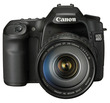Monday, September 3. 2007
Ultimate lens considerations, II

I thought a little more about what my first lenses could be, and I got inspired by one photographer’s gallery on the web. He shows many pictures living from narrow depths of field and low f-stops e.g. at f/2.8. He even shows some portraits taken with a 50mm f/1.4 lens at low light or showing awesome narrow depths of field. Therefore I noticed that having a faster lens is more important than high focal lengths, and a DSLR camera body can be used for several years without leering towards FF sensors, what that photographer showed by using an EOS 20D. After some searching I found a different scenario of lenses while coming to lower prices due to the preference of Sigma to Canon. Btw, I found out that the teleconverters can only be used for tele lenses.
 Previously I was considering the Canon EF 24-105mm f/4L IS USM [Review] as first lens. Compared to the miniature film equivalence of my PowerShot, what is @35-210mm with f/2.8-4.8, that lens covers @38-168mm and almost reaches the upper limit of @210mm. However, it only has an aperture of f/4. Sure, the IS allows longer exposures, but low f-stops and therefore very narrow depths of field aren’t possible. In addition, it’s rather expensive with €999. Luckily I found an interesting alternative, what I will mention below.
Previously I was considering the Canon EF 24-105mm f/4L IS USM [Review] as first lens. Compared to the miniature film equivalence of my PowerShot, what is @35-210mm with f/2.8-4.8, that lens covers @38-168mm and almost reaches the upper limit of @210mm. However, it only has an aperture of f/4. Sure, the IS allows longer exposures, but low f-stops and therefore very narrow depths of field aren’t possible. In addition, it’s rather expensive with €999. Luckily I found an interesting alternative, what I will mention below.
 The Tokina 12-24mm f/4 AT-X PRO DX [Review] has no ultrasonic autofocus motor, but it’s simply a good wide angle lens, and a constant value of f/4 is not so self-evident. The low @19mm are really useable. This will be my second lens for sure, and its upper focal length of @38mm should perfectly end at the beginning of the next higher lens. The €549 are quite a bit much at my preferred dealer, I could get it for €485 where I intend to buy the batteries, but I’ll often use the wide angle range, justifying the purchase.
The Tokina 12-24mm f/4 AT-X PRO DX [Review] has no ultrasonic autofocus motor, but it’s simply a good wide angle lens, and a constant value of f/4 is not so self-evident. The low @19mm are really useable. This will be my second lens for sure, and its upper focal length of @38mm should perfectly end at the beginning of the next higher lens. The €549 are quite a bit much at my preferred dealer, I could get it for €485 where I intend to buy the batteries, but I’ll often use the wide angle range, justifying the purchase.
 I finally found a very reasonable tele lens: The Sigma 70-200mm f/2.8 EX DG APO HSM IF Macro [Review] costs only half as much as the equivalent model by Canon, namely €979, what is very reasonable. Sure, it doesn’t have Sigma’s Optical Stabilizer, but a constant f/2.8 is very high, and it even has a macro function (though only with a magnification of 1:3.5). Unfortunately, it got no recommendation in ColorFoto 09/2007 for use on the EOS 20D, but just because the expensive Canon lens provided better values. But it did get a recommendation for the Nikon D200, and other users say that it can compete with the Canon. With that lens I can do good portraits at the lower @112mm at f/2.8, and still have f/2.8 at the upper @320mm, what is quite high. And did I mention it has a macro function?
I finally found a very reasonable tele lens: The Sigma 70-200mm f/2.8 EX DG APO HSM IF Macro [Review] costs only half as much as the equivalent model by Canon, namely €979, what is very reasonable. Sure, it doesn’t have Sigma’s Optical Stabilizer, but a constant f/2.8 is very high, and it even has a macro function (though only with a magnification of 1:3.5). Unfortunately, it got no recommendation in ColorFoto 09/2007 for use on the EOS 20D, but just because the expensive Canon lens provided better values. But it did get a recommendation for the Nikon D200, and other users say that it can compete with the Canon. With that lens I can do good portraits at the lower @112mm at f/2.8, and still have f/2.8 at the upper @320mm, what is quite high. And did I mention it has a macro function?
 And because I was so inspired by pictures using low f-stops, I consider the Canon EF 50mm f/1.4 USM [Review] as a possible future lens for high quality portraits. This will enable good pictures at low light, and good portraits with incredible narrow depth of field. And all this for only €369, what is really not the price range of fast zoom lenses.
And because I was so inspired by pictures using low f-stops, I consider the Canon EF 50mm f/1.4 USM [Review] as a possible future lens for high quality portraits. This will enable good pictures at low light, and good portraits with incredible narrow depth of field. And all this for only €369, what is really not the price range of fast zoom lenses.
Now I could draw the following picture of focal length coverage and aperture values of the mentioned lenses (on an APS-C sensor with crop 1.6):
Continue reading "Ultimate lens considerations, II"
